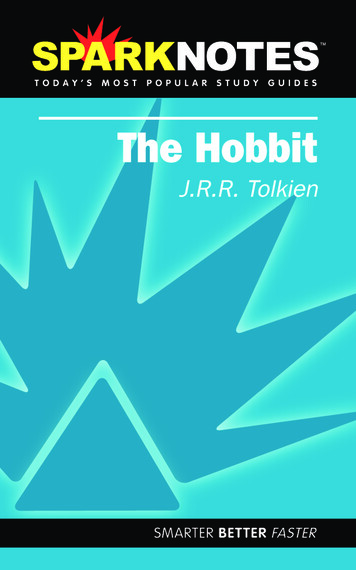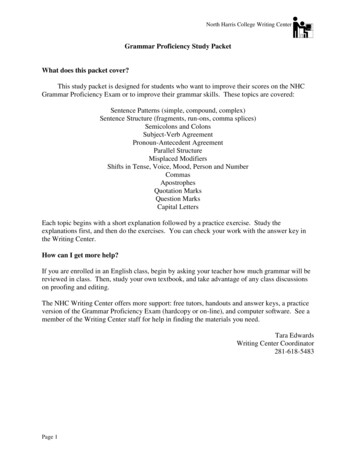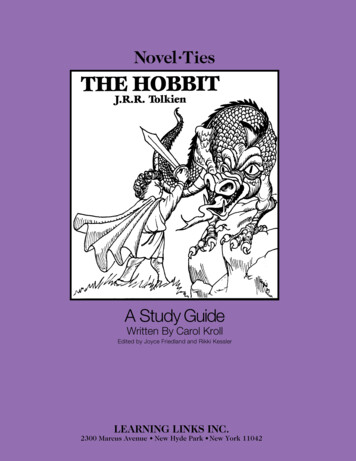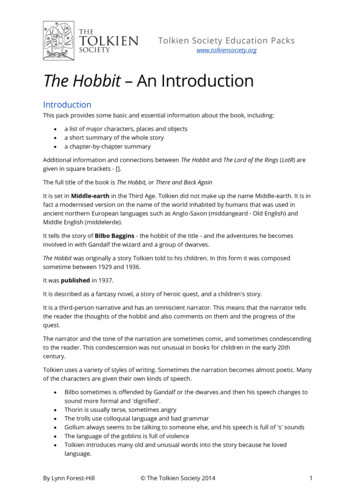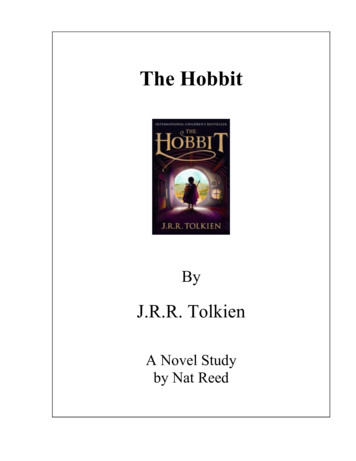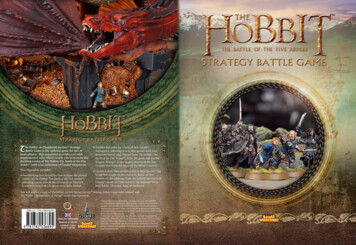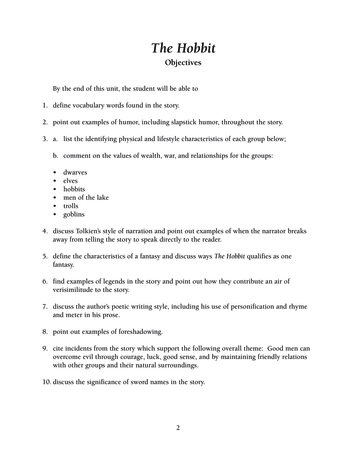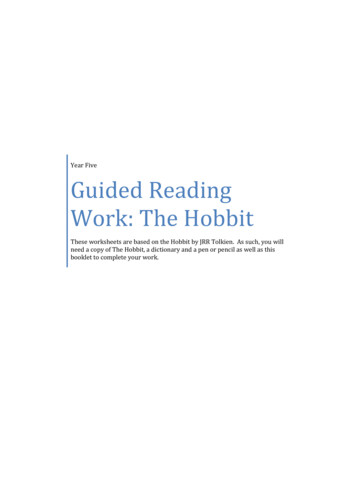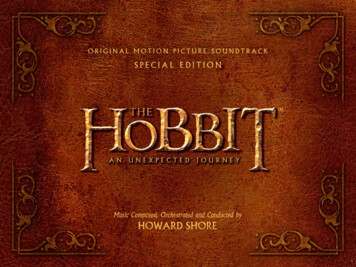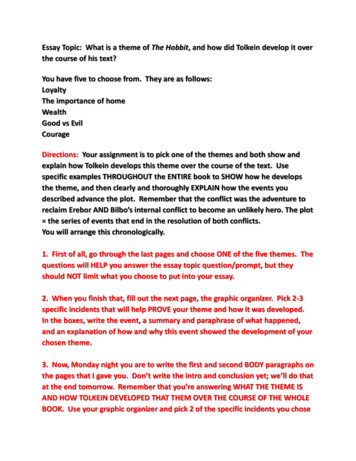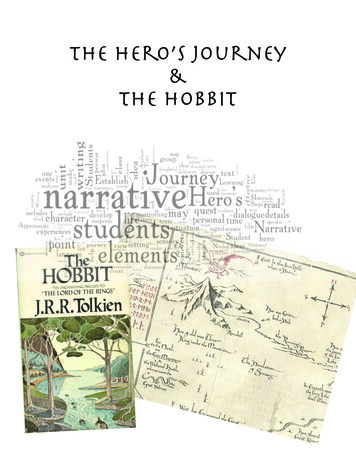
Transcription
The Hero’s Journey&The Hobbit
The Hero's Journey: Summary of the Stepsby: Joseph CampbellThe Ordinary World - Here the person is introduced to the audience. Hedoesn't know his personal potential or calling.Call to Adventure - The call to adventure is the point in a person's life whenhe is first given notice that everything is going to change, whether heknows it or not.Refusal of Call/Reluctant Hero - Often when the call is given, the futurehero refuses to heed it. This may be from a sense of duty or obligation,fear, insecurity, a sense of inadequacy, or any of a range of reasons thatwork to hold the person in his current circumstances.Meeting Wise Mentor - Once the hero has committed to the quest,consciously or unconsciously, his guide and magical helper appears, orbecomes known.The First Threshold - This is the point where the person actually crosses intothe field of adventure, leaving the known limits of his world and venturinginto an unknown and dangerous realm where the rules and limits are notknown.Tests, Allies and Enemies - The road of trials is a series of tests, tasks, orordeals that the person must undergo to begin the transformation. Oftenthe person fails one or more of these tests, which often occur in 3s.Supreme Ordeal- This is sometimes described as the person's lowest pointor darkest moment. The separation has been made between the oldworld and old self and the potential for a new world/self. By entering thisstage, the person shows her/his willingness to make a change, to die andbecome a new person.
Revisiting the Mentor - The person revisits the teachings of an old mentoror meets and learns from a new mentor and subsequently returns to thepath s/he started on.Return with New Knowledge- The trick in returning is to retain the wisdomgained on the quest, to integrate that wisdom into a human life, and thenmaybe figure out how to share the wisdom with the rest of the world. This isusually extremely difficult. Just as the hero may need guides and assistantsto set out on the quest, often times he or she must have powerful guidesand rescuers to bring them back to everyday life, especially if the personhas been wounded or weakened by the experience.Seizing the Sword (or Prize)- Here the hero confronts and defeats oldenemies with the new power and knowledge gained. S/he is able tooverthrow or defeat the opponent.Resurrection -The old self dies physically or spiritually and moves beyondthe normal human state. This is a god-like state where the heroacknowledges her/his new stature. Another way of looking at this step isthat it is a period of rest, peace and fulfillment before the hero begins thereturn.Return with Elixir* - The return with elixir is the achievement of the goal ofthe quest. It is what the person went on the journey to get. All the previoussteps serve to prepare and purify the person for this step, since in manymyths the elixir is like a plant, or a magic potion or medicine, that suppliesimmortality. For a human hero, it means achieving a balance betweenmaterial and spiritual world. There is freedom to live and freedom from thefear of death. This is sometimes referred to as "living in the moment".*magic potion or medicine
The 12 Stages1.2.3.4.5.6.7.8.9.10.11.12.The Ordinary WorldThe Call to AdventureRefusal of the CallMeeting with the MentorCrossing the ThresholdTests, Allies, and EnemiesApproachThe OrdealThe RewardThe Road BackThe ResurrectionReturn with the Elixir!The Hero’s Journey
Hero’s Journey Character ArchetypesHeroThe protagonist or central figures in a story who goes on the journey/quest.MentorThe hero’s guide/teacher through the quest. The mentor helps the hero find theirstrengths and abilities.Threshold GuardianThe forces that stand in the way at important turning points in the story; thiscould include enemies or your own fears and doubts.HeraldA person, object, or event that brings the hero’s “call to adventure.ShapeshifterThe role of the shapeshifter is to question and deceive. The shapeshifter can begood or evil. Their change can be physical (vampire) or functional (a herald becomesa mentor). Often misleads the hero or causes doubts in the hero.ShadowThe shadow is the hero’s antagonist. The shadow could also be the hero’s owninternal enemies — doubt, anger, fear, and grief.TricksterThe role of the trickster is to disrupt, make mischief, and sometimes to defy. Oftena humorous sidekick or ally.Allies/HelpersCharacters who help the hero through the changes and challenges of the journey/quest. Sidekicks, buddies, romantic partners who advise the hero through thetransitions of life.
The HobbitGuiding QuestionsInstructions: Read over these broad guiding questions carefully before youbegin the book. As you read, consider these concepts and use sticky notes or aninformal journal to identify sections of the text that reflect answers or provideinsight to these questions. Understanding and awareness of these questions willresult in success on assignments you will receive after the school year begins.1. What is the author saying about society? What does it mean to be a part of agroup or a society? How does group identity affect personal identity?2. How do group or relationship dynamics change as time progresses? How dorelationships in the book affect character development?3. How and why does the writer use irony throughout the book? Look forexamples of irony in dialogue, situations, characters, and theme.4. How does the complex nature of the protagonist’s personality drive the plotand reveal universal themes in the text? Explain.5. Which characters are dynamic and which are static? Explain.6. How is the setting important to the text? How do the different settings (asthe characters go on their journey) influence universal themes in the text?7. How does this book reflect archetypal themes, plot elements, and characters?8. How does the author use word choice and figurative language to createmeaning in the text? Be prepared to identify specific examples of diction andliterary devices and discuss their effect and purpose.9. How are the themes of this book relevant today? Be prepared to identify anddiscuss modern examples of themes, concepts and situations that are reflectedin the book.10. What is your personal connection with the book? What in the book remindsyou of personal experiences or observations?
The HobbitVocabulary Listattercop a spider; an ill-natured personaudacious - bold or daringBard a poetbenighted - confused in the darkbesieged surrounded in a hostile mannerbilbo a sword, a rapierblighter a contemptible fellowcarrion decaying flesh of a dead bodycavalcade - a procession of people on horsebackclamor a great outcry; noiseconspirator - a person who takes part in a conspiracycronies friendsenmity hostilityeyrie the nest of an eagle, located in a high placeflummoxed - to confused or perplexedforded crossed a river or other body of waterhart a male dearlaburnums- small, poisonous trees and shrubsmattocks a tool like a pickax with a flat blade, used for loosening the soilnecromancer - someone who claims to be able to tell the future by communicating with the deadthrough black magic; a sorcererpalpitating - a rapid of the heartportcullis - a strong barrierprecipice a vertical cliff; a very steep placepurloined - stolenquay a pier or landing area for shipsquoits a game where players throw rings at a peg in the groundreconciliation - to become friends again; to settle differencesremuneration - a reward or compensationrending tearing, bursting, splittingrent torn or rippedrunes writings done in an ancient scriptscimitar a curved bladed swordsmite to hit with a blowsuccored aided, helped, assistedthrong a great number of people gathered together; a crowdtomnoddy - a blockhead, dolt, or duncetoothsome - pleasing to the tastevanguard the troops who march in front of the armyvenerable - worthy of respect because of age or dignitywatercourse - a stream of water; a channel for water4
The HobbitTerms and DefinitionsProverb - a short saying that states a basic truth about life. Example: He who hesitates is lost.Third Person Narrative—a manner of storytelling in which the narrator is not a characterwithin the events related but stands outside those events. In a third-person narrative, allcharacters within the story are, therefore, referred to as he, she, it, or they.Flashback - A scene that interrupts the ongoing action in a story to show an event that happened earlier.Legend – a story which is only partly true about a real or made-up character; a fable.Legends usually include exaggerations and unusual events or circumstances. Example:Paul Bunyan changing the course of the Pecos River.Foreshadowing – the use of hints or clues in a story to suggest what action is to come.Foreshadowing is frequently used to create interest and build suspense.Style - the way an author chooses and uses words, phrases, and sentences to tell the story.For example, in an action/adventure story, the author may use simple words and short,choppy sentences, because this style moves the story along quickly. But in a story abouta college professor, the same author may choose to use polysyllabic, unfamiliar wordsand long, convoluted sentences.Irony - a subtle, sometimes humorous perception of inconsistency in which the significanceof a statement or event is changed by its content. For example: the firehouse burneddown. Dramatic irony - the audience knows more about a character’s situation than thecharacter does, foreseeing an outcome contrary from the character’s expectations. Thecharacter’s statements have one meaning for the character and a different meaning tothe reader, who knows more than the character. Structural irony - a naïve hero whose view of the world differs from the author’s andreader’s. Structural irony flatters the reader’s intelligence at the expense of the hero. Verbal irony - a discrepancy between what is said and what is really meant; sarcasm.Example: calling a stupid man smart.Personification - a figure of speech in which an object or animal is given human characteristics. Example: The pig laughed all the way to the barn.Prose - the ordinary form of written or spoken language, without rhyme or meter; speech orwriting that is not poetry.10
Theme - The central or dominant idea behind the story; the most important aspect thatemerges from how the book treats its subject. Sometimes theme is easy to see, but, atother times, it may be more difficult. Theme is usually expressed indirectly, as an element the reader must figure out. It is a universal statement about humanity, ratherthan a simple statement dealing with plot or characters in the story. Themes are generally hinted at through different devices: a phrase or quotation that introduces thenovel, a recurring element in the book, or an observation made that is reinforcedthrough plot, dialogue, or characters. It must be emphasized that not all works of literature have themes in them.In a story about a man who is diagnosed with cancer and, through medicine andwill-power, returns to his former occupation, the theme might be: “real courage isdemonstrated through internal bravery and perseverance.” In a poem about a flowerthat grows, blooms, and dies, the theme might be: “youth fades and death comes toall.”Fantasy – a work of fiction that does not represent the real world. It may include nonhuman, animal, or alien characters, unreal settings, or impossible occurrences. Example:J.R.R. Tolkien’s Ring TrilogySlapstick - crude comedy in which the humor comes from horseplay or violent activity suchas slapping or fighting.Verisimilitude - the semblance of truth or reality in a literary work.Deus ex Machina – the intervention into the plot of a person, force, or unexpected occurrence which resolves a seemingly impossible situation. Example: A forest is about to bedestroyed, along with the hero, by a fire, but a drenching rain suddenly puts out theblaze.11
Character ListBilbo Baggins - Bilbo is a hobbit and the main character of our story.Gandalf - A wise old wizard who always seems to know more than he reveals. Recruits the reluctant Bilbo for the quest.Thorin Oakenshield - A dwarf who leads his fellow dwarves on a trip to the Lonely Mountain to reclaim their treasurefrom Smaug.The party of Dwarves - The other dwarves that accompany them on the quest include: Fili, Kili, Dwalin, Balin, Oin, Gloin,Ori, Dori, Nori, Bifur, Bofur, and Bombur.Gollum - A strange, small, slimy creature who lives deep in the caves of Moria beneath the Misty Mountains.Smaug - The great dragon who lives in the Lonely Mountain which he stole from the dwarves, along with all of theirtreasure.Bard - The human who is the honorable captain of the guard in Lake TownBeorn - A man who can turn into a bear, Beorn helps Bilbo and the dwarves after their escape from the goblins.Elrond - The great leader of the elves at Rivendell.Elves - The first creatures in Middle-Earth. They are fair-faced, with beautiful voices, and have a close communion withnature, which makes them wonderful craftsmen. The wood Elves live in Mirkwood, close to Lake Town and the LonelyMountain and are therefore very cautious and suspicious of outsiders.Humans - Humans appear in the settlement of Lake Town near the Lonely Mountain.Trolls - Short-tempered and dull-witted creatures who will eat just about anything. They turn to stone in daylight.Goblins - Evil creatures that make cruel weapons and torture devices.Wargs - Evil wolves that join forces with the Goblins at the Battle of the Five Armies3
Important Location in the StoryHobbiton (The Shire): Home of the HobbitsLonely Mountain: Former home of the dwarves, taken by SmaugMirkwood: Forest outside of the Lonely Mountain; Home to the Wood ElvesDale: Once a city of Men along the river to Long Lake and the Lonely Mountain, destroyed by SmaugMisty Mountains: Home of the GoblinsRivendell: Home of ElronLong Lake: Location of Laketown, in the shadow of the Lonely MountainLake-Town (Esgaroth): A human town built in the middle of Long Lake that has been menaced by Smaug4
A List of Helpful Vocabulary WordsAttercop: A type of spider or a peevish, ill-natured person.Bracken: A type of fern or an area overgrown with ferns and shrubs.Eyrie: The nest of a bird, such as an eagle, built on a cliff or other high place.Flummoxed: Confused; perplexed.Mattocks: A digging tool with a flat blade set at right angles to the handle that can also be used as aweapon.Palpitate: To pulsate with unusual rapidity from exertion, emotion, disease, etc.Porter: A dark beer resembling light stout, made from malt browned or charred by drying at a hightemperature.Prosy: Dull; commonplace; arousing no interest, attention, curiosity, or excitement.Slowcoach: Someone who moves slowly; a “slowpoke.”Solemnities: State or character of being serious or somber; earnestness; formal.Tomnoddy: A fool or a dunce.Tuppence: A very small amount of English money, similar to American pennies.Turnkey: A person who has charge of the keys of a prison; jailer.5
Explanation of the Hero’s JourneyWhat is a hero?In literature, “The hero is the character who conquers obstacles and saves the day. Typically the hero embarks on somequest, either physical or spiritual. The hero could be a knight in shining armor, a police officer or a politician who pushesfor bold reforms. Specific examples include Robin Hood, Luke Skywalker and Wonder Woman. The quality that makes acharacter truly heroic is his willingness to put others ahead of himself” 1.What is his journey?The Hero must go through a process in order to become a hero. The first step is “The Mundane World”. The Hero beginsin a place of safety and/or comfort that they either long to leave or are reluctant to depart from. In the second stage,the Hero experiences a “Call to Adventure”. Someone or something tells The Hero there is something else out there.The Hero may also learn of a special role, talent, or destiny they possess. Next, the hero “Crosses into a New World”.The Hero leaves the comforts of home behind and enters into a new world filled with both adventure and danger. He orshe must go through “The Path of Trials” in order to grow and become the hero. The Hero goes on an adventure,meeting new people (friends, mentors, and enemies), learning new skills, and overcoming challenges. In the end he/shebecomes “A Master of Two Worlds”. Having successfully completed their adventure in the “new world” The Heroreturns home a changed person.Bilbo is a hero and undergoes this hero’s journey. While you read, you will be finding quotes from the book to prove thisfact.A Masterof TwoWorldsTheMundaneworldThe Pathof TrialsThe World ofAdventure1The “Old” World or“Home” of the heroThe Call toAdventureCrossinginto a newworldPatrick, Josh. "List of Frequent Archetypes in Literature." EHow.com. Demand Media, 07 Apr. 2011. Web. 30 Apr. 2013.6
Explanation of Quote Collection SheetIt is important to look for quotes while you are reading the book. As you read, you willneed to find at least 2 quotes for each of the stages of the hero’s journey (10 quotes TOTAL).Use this chart to organize this information. Remember, these quotes are not just what peoplesay; rather they are any line that helps us to understand the journey and the changes thatBilbo is experiencing. I have given you one example of a quote that you might have chosenwhile you were reading.Explanation of BoxesPage #Quote – Remember, are any line that helps us to understand the journey and thechanges that Buck is experiencing.Explanationof Quote:In this space please explain why you chose this quoteExamplePage # 1“In a hole in the ground it was a hobbit-hole, and that means comfort.”ExplanationThis quote describes the comfortable “mundane world” that Bilbo comesof Quote:from. He lives a very easy life without adventure.
NameQuote Collection Sheet“The Mundane World”These quotes show: What is Bilbo like before being recruited? (Did he want to go?)Page #QuoteExplanationof Quote:Page #QuoteExplanationof Quote:“The Call to Adventure”These quotes show: His first experiences. What does he learn? What special talents/traits does he have?Page #QuoteExplanationof Quote:Page #Explanationof Quote:Quote
“Crossing into a New World”These quotes show: What dangers does he face? How is he changing?Page #QuoteExplanationof Quote:Page #QuoteExplanationof Quote:“The Path of Trials”These quotes show: Adventures, people he meets, skills he learns, how he overcomes challenges.Page #QuoteExplanationof Quote:Page #Explanationof Quote:Quote
“The Master of Two Worlds”These quotes show: How he has changed by the end of the book. Is home the same for him now?Page #QuoteExplanationof Quote:Page #Explanationof Quote:Quote
Specific Questions by ChapterDirections: As you read the novel, answer the following questions in complete sentences. Each answershould be a MINIMUM of two sentences, but be sure to answer ALL PARTS OF THE QUESTION. You maytype or write your answers, but be sure that they are legible. If we cannot read your handwriting, it will bemarked wrong!Chapter 1 – How does Bilbo react to the arrival of the dwarves on his doorstep? What does he do and howdoes he act? Why do you think he doesn’t throw them out?Chapter 2 – What unexpected danger does the party stumble upon? How does Bilbo mess up and how doesGandalf rescue them?Chapter 3 – How does Elrond assist Bilbo and the Dwarves/Chapter 4 – What causes the Great Goblin to become enraged at Thorin and company?Chapter 5 – How does Bilbo outwit Gollum – in the game and at the very end? Was Bilbo’s behavior correct ordid he do anything unethical?Chapter 6 – How do the Goblins and Wargs trap Bilbo, Gandalf, and the Dwarves? How do they escape?Chapter 7 – What is special about Beorn? How does Gandalf have the Dwarves approach his home?
Chapter 8 – How does Bilbo prove his worth against the spiders? What does this show about Bilbo and howhe is changing?Chapter 9 – How does Bilbo again prove his worth when the Dwarves are imprisoned by the Wood Elves?How do they escape?STOP AND THINK – Bilbo has changed a lot since the beginning of the adventure. What do you think was theturning point for Bilbo? What qualities of a hero does he possess?Chapter 10 – How are Thorin and Company welcomed in Laketown?Chapter 11 – How does Bilbo discover the key hole?Chapter 12 – What valuable piece of information does Bilbo learn about the dragon? Who does Smaug cometo believe Bilbo is?Chapter 13 – What valuable treasure does Bilbo hide from the Dwarves and why?
Chapter 14 – How is Smaug defeated, and by whom? How do they know about Smaug’s weakness?Chapter 15 – What leads to conflict between the men, elves, and the dwarves? What does this show aboutthe Dwarves nature?Chapter 16 – What fateful decision does Bilbo make that goes against the wishes of Thorin and company?Chapter 17 – What are the Five Armies in the Battle of the Five Armies? Who dies with whom and why?Chapter 18 – Describe the final meeting between Thorin and Bilbo?Chapter 19 –What do the other Hobbits think of Bilbo upon his return to Hobbiton? How does Bilbo feel andis he still the same Hobbit? What qualities have emerged that were not there before?STOP and THINK – Was Thorin a hero? What qualities did he possess and also what were his flaws? Whatqualities did Bilbo possess that allowed him to avoid the vices that caused Thorin’s downfall?
How to Write a Character Analysis in 10 Easy StepsIntroductionAs you were reading your assigned work, you had probably been engaging in an informal character analysis without evenknowing it, whether from your own opinions, text you selected to highlight, or notes that you wrote. With a little guidance on whatto do with those various notations, writing a character analysis should not be a problem!1) Pay attention to the character’s ethics. Does the character make just or unjust choices? Consider Atticus Finch in HarperLee’s To Kill a Mockingbird. Atticus does not make morally correct choices only when it is convenient for him to do so. Rather,he shows he’s a truly just character by sticking to his principles even when his life is at stake.2) Decide whether the character’s actions are wise or unwise. For example, one may think of Friar Laurence inShakespeare’s Romeo and Juliet as being a character who continually makes poor decisions that reflect his inner corruption.3) What is the character’s motivation? As you are mulling over the pros and cons of each character’s internal thoughts andexternal actions, you will want to also consider why the character is acting or thinking in a particular way. Has the author givenyou any clues about the character’s past? In Amy Tan’s novel The Joy Luck Club, Lindo Jong’s domination of her daughterWaverly can be understood, if not entirely excused, by her terrible experiences in China.4) Consider the effects of the character’s behavior on other characters. Jane Austen’s Pride and Prejudice is rife with theeffects of one character’s actions on others. When Lydia decides to run off with the charlatan Wickham, she puts the wholefamily’s reputation, as well has her own, at risk, and even involves those outside her family, like Darcy.5) Look for repeatedly used words that describe the character. Those words often give insight into a character’spsychology and motivations. In John Steinbeck’s novel East of Eden, Kathy is frequently referred to as having “sharp little teeth”and a “flickering tongue,” which are symbols of her snake-like monstrousness.6) Be aware of items associated with the character. They may say something about his or her state of mind. A classicexample is the delicate unicorn figurine in Tennessee Williams’ play The Glass Menagerie. The figurine is symbolic of Laura’sown sense of hope and her own fragility.7) Read between the lines. Often what a character does not say is as important as what he or she does say. Think of AbnerSnopes in William Faulkner’s short story “Barn Burning.” When the court finds Snopes guilty of ruining his boss’ rug, priorknowledge of Abner’s character tells us that his silence upon hearing the verdict actually speaks volumes. We know he will reactlater.and violently.8) Is the character “flat” or “round”? A character is considered flat (or static) when he or she does not experience change ofany kind, does not grow from beginning to end. Shakespeare often uses comic villains as flat characters, like Don Jon in MuchAdo About Nothing. Round characters are those who do experience some sort of growth, like Nora in Henrik Ibsen’s A Doll’sHouse. By the end of the play, she has gone from being meek and submissive to being strong and liberated.9) Consider the historical time period of the character. Refrain from making modern judgments about the past; put thecharacter’s actions and thoughts in context. A female character living in England in the 1800s obviously could not make thechoices that she could today, for both political and social reasons.10) Finally, what does the author think? Look for any of the author’s own judgments about the characters he or she hascreated. The author may be directing you toward an intended interpretation. In The Scarlet Letter, Nathaniel Hawthornecertainly meant for his readers to see Hester as good and Chillingsworth as evil.
Character Trait ExamplesLearner ncipledCommunicatorAdditional yupsetusefulwarmweakwickedwiseworried
Types of Characters in Fiction"What does characterization do for a story? In a nutshell, it allows us to empathize with the protagonistand secondary characters, and thus feel that what is happening to these people in the story is vicariouslyhappening to us; and it also gives us a sense of verisimilitude, or the semblance of living reality. Animportant part of characterization is dialogue, for it is both spoken and inward dialogue that afford us theopportunity to see into the characters' hearts and examine their motivations. In the best of stories, it isactually characterization that moves the story along, because a compelling character in a difficult situationcreates his or her own plot."Karen Bernardo, Characterization in LiteratureIn fictional literature, authors use many different types of characters to tell their stories.Different types of characters fulfill different roles in the narrative process, and with a littlebit of analysis, you can usually detect some or all of the types below.Major or central characters are vital to the development and resolution of theconflict. In other words, the plot and resolution of conflict revolves around thesecharacters.Minor characters serve to complement the major characters and help move theplot events forward.Dynamic - A dynamic character is a person who changes over time, usually asa result of resolving a central conflict or facing a major crisis. Most dynamiccharacters tend to be central rather than peripheral characters, becauseresolving the conflict is the major role of central characters.Static - A static character is someone who does not change over time; his orher personality does not transform or evolve.Round - A rounded character is anyone who has a complex personality; he orshe is often portrayed as a conflicted and contradictory person.Flat - A flat character is the opposite of a round character. This literarypersonality is notable for one kind of personality trait or characteristic.Stock - Stock characters are those types of characters who have becomeconventional or stereotypical through repeated use in particular types ofstories. Stock characters are instantly recognizable to readers or audiencemembers (e.g. the femme fatale, the cynical but moral private eye, the madscientist, the geeky boy with glasses, and the faithful sidekick). Stock charactersare normally one-dimensional flat characters, but sometimes stock personalitiesare deeply conflicted, rounded characters (e.g. the "Hamlet" type).Protagonist - The protagonist is the central person in a story, and is oftenreferred to as the story's main character. He or she (or they) is faced with aconflict that must be resolved. The protagonist may not always be admirable (e.g.an anti-hero); nevertheless s/he must command involvement on the part of thereader, or better yet, empathy.Antagonist - The antagonist is the character(s) (or situation) that represents theopposition against which the protagonist must contend. In other words, theantagonist is an obstacle that the protagonist must overcome.
Anti-Hero - A major character, usually the protagonist, who lacks conventionalnobility of mind, and who struggles for values not deemed universally admirable.Duddy, in Mordecai
The Hobbit Vocabulary List attercop - a spider; an ill-natured person audacious - bold or daring Bard - a poet benighted - confused in the dark besieged - surrounded in a hostile manner bilbo - a sword, a rapier blighter - a contemptible fellow carrion - decaying flesh of a dead body cavalcade - a procession

